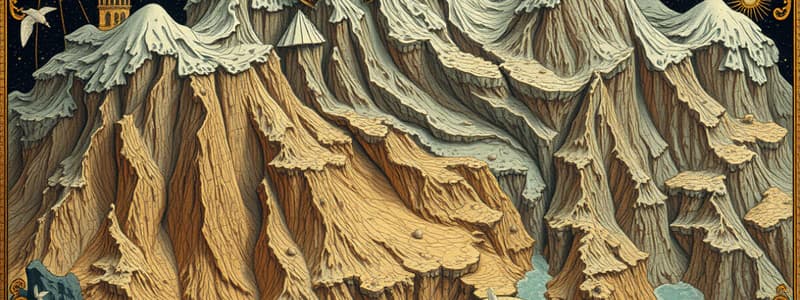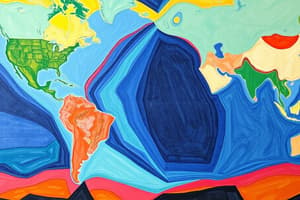Podcast
Questions and Answers
What is a geological plate?
What is a geological plate?
A geological plate is a structure approximately 100 km deep, constituting the uppermost part of the Earth, including the crust and upper mantle.
What primarily composes the continental crust?
What primarily composes the continental crust?
- Metamorphic rocks
- Sedimentary rocks
- Basaltic rocks
- Granite rocks (correct)
What is the primary composition of the oceanic crust?
What is the primary composition of the oceanic crust?
- Granite rocks
- Sandstone
- Basaltic rocks (correct)
- Limestone
What is the largest lithospheric plate?
What is the largest lithospheric plate?
Which of the following is a type of destructive plate margin?
Which of the following is a type of destructive plate margin?
Constructive plate margins create new oceanic crust.
Constructive plate margins create new oceanic crust.
What is the process called when one tectonic plate is forced beneath another?
What is the process called when one tectonic plate is forced beneath another?
What are the 7 major lithospheric plates?
What are the 7 major lithospheric plates?
The underwater crust is primarily composed of ______ rocks.
The underwater crust is primarily composed of ______ rocks.
Flashcards are hidden until you start studying
Study Notes
Plate Tectonics Overview
- Plates are geological structures about 100 km deep, comprising the Earth's crust and upper mantle, known as lithospheric plates.
- Plates float over the asthenosphere and are in constant motion, studied in the field of tectonics.
Types of Plates
- Continental Plate: Lies beneath landmasses, primarily granite composition, such as the Eurasian Plate which is partly submerged in water.
- Oceanic Plate: Exists beneath oceans, primarily composed of basaltic rocks.
- Continental-Oceanic Plate: Contains both land and ocean, with granite under land and basalt under ocean, like the Indo-Australian Plate and Pacific Plate, which is the largest plate.
Major and Minor Plates
- Major Plates include:
- Eurasian Plate (Continental)
- Pacific Plate (Oceanic)
- African Plate
- Indo-Australian Plate
- North American Plate
- South American Plate
- Antarctic Plate
- Minor Plates consist of:
- Philippine Plate
- Burma Plate
- Caribbean Plate
- Nazca Plate
- Juan de Fuca Plate
- Cocos Plate
- Arabian Plate
- Anatolian Plate
- Java Plate
Types of Plate Margins
- Destructive Plate Margins: Occur at convergent boundaries where plates collide, leading to subduction of one plate beneath another.
- Constructive Plate Margins: Found in divergent areas where plates move apart and magma rises to create new crust, forming mid-ocean ridges.
- Conservative Margins: Plates slide past one another along transform faults without creating or destroying crust. Can lead to significant earthquakes, e.g., San Andreas Fault.
Constructive Plate Margins / Divergent Boundaries
- Characterized by mid-ocean ridge formation, starting with intra-continental rifting:
- Intra-continental Rifting: Hot magma rises, causing domal uplift and cracking the crust.
- An example includes the Ethiopian Highlands, displaying domal uplift.
- Ongoing magma interaction with the crust pulls continents apart, creating rift valleys through faulting processes.
Studying That Suits You
Use AI to generate personalized quizzes and flashcards to suit your learning preferences.




